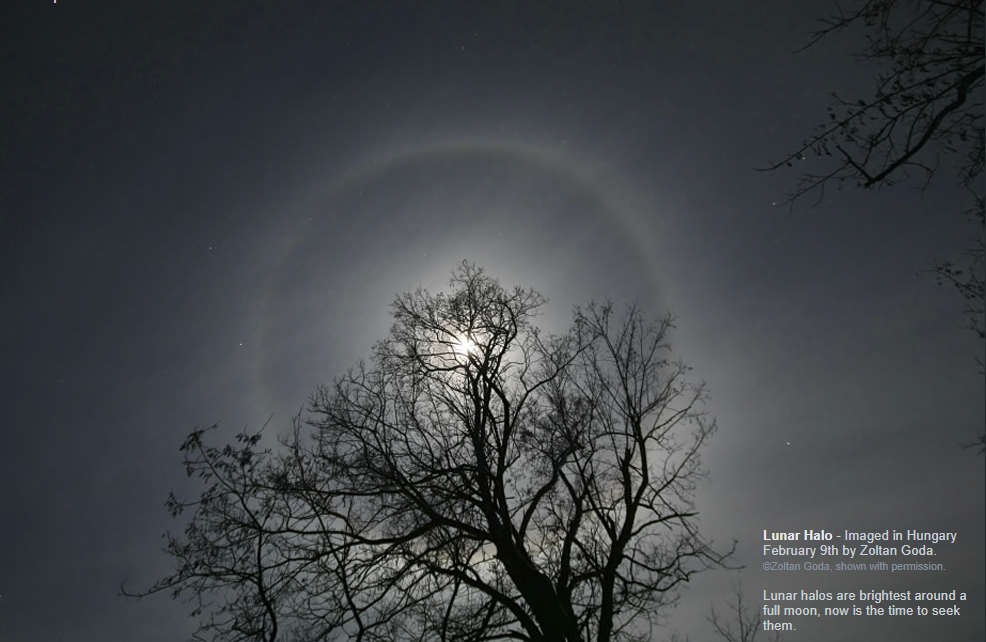Lunar Halo
Lunar Halo: A Mesmerizing Optical Phenomenon
Have you ever looked up at the night sky and noticed a luminous ring encircling the moon? This captivating sight is known as a lunar halo. It occurs when light from the moon interacts with ice crystals in the Earth's atmosphere, resulting in a stunning display of atmospheric optics. While lunar halos can be observed throughout the year, they are particularly pronounced around a full moon, making this the perfect time to seek out these ethereal wonders.
Lunar halos have fascinated sky watchers for centuries, inspiring awe and wonder. These celestial phenomena are created when moonlight passes through hexagonal ice crystals suspended in the atmosphere. As the light enters the crystal, it undergoes refraction, bending at an angle. The bent light then exits the crystal, creating a circular halo around the moon. The size and intensity of the halo depend on various factors such as the size and shape of the ice crystals, as well as the angle at which they are oriented.
The diameter of a lunar halo is typically larger than that of the moon itself, spanning about 22 degrees. This means that the halo forms a complete circle with the moon at its center. However, under certain atmospheric conditions, the halo can appear larger or smaller. Occasionally, lunar halos may even exhibit vivid colors, similar to those seen in rainbows. These colorful halos occur due to the dispersion of light within the ice crystals, separating it into its component colors.
To observe a lunar halo, you need clear skies and a full moon. Find a location away from artificial lights to minimize light pollution and enhance your viewing experience. Once you have positioned yourself, direct your gaze towards the moon and look for a luminous ring surrounding it. Take a moment to marvel at this natural spectacle and contemplate the beauty of our atmosphere.
While lunar halos are undoubtedly captivating, they are not exclusive to Earth. Similar phenomena can also occur on other celestial bodies, such as Mars and Saturn's moon, Titan. These extraterrestrial halos offer scientists valuable insights into the atmospheric conditions of these distant worlds. By studying the properties and formation of lunar halos, researchers can gain a deeper understanding of atmospheric optics and its role in shaping the appearance of celestial bodies.
In addition to lunar halos, there are several other optical phenomena that can occur in the Earth's atmosphere. Some of these include sun halos, sundogs, and iridescent clouds. Each of these phenomena is caused by the interaction of sunlight with atmospheric particles or ice crystals. Exploring these various optical wonders can open up a whole new world of atmospheric beauty and provide a deeper appreciation for the intricate workings of our planet's atmosphere.
So, the next time you find yourself gazing at the night sky, take a moment to look for a lunar halo. Allow yourself to be captivated by its enchanting beauty and contemplate the intricate interplay between light and ice crystals in our atmosphere. These celestial displays serve as a reminder of the immense complexity and wonder that exists above us, waiting to be discovered and appreciated. Embrace the magic of atmospheric optics and let it ignite your curiosity about the mysteries of our universe.

Lunar Halo - Imaged in Hungary February 9th by Zoltan Goda. ©Zoltan Goda, shown with permission.
Lunar halos are brightest around a full moon, now is the time to seek them.
Note: this article has been automatically converted from the old site and may not appear as intended. You can find the original article here.
Reference Atmospheric Optics
If you use any of the definitions, information, or data presented on Atmospheric Optics, please copy the link or reference below to properly credit us as the reference source. Thank you!
-
<a href="https://atoptics.co.uk/blog/lunar-halo/">Lunar Halo</a>
-
"Lunar Halo". Atmospheric Optics. Accessed on November 26, 2024. https://atoptics.co.uk/blog/lunar-halo/.
-
"Lunar Halo". Atmospheric Optics, https://atoptics.co.uk/blog/lunar-halo/. Accessed 26 November, 2024
-
Lunar Halo. Atmospheric Optics. Retrieved from https://atoptics.co.uk/blog/lunar-halo/.